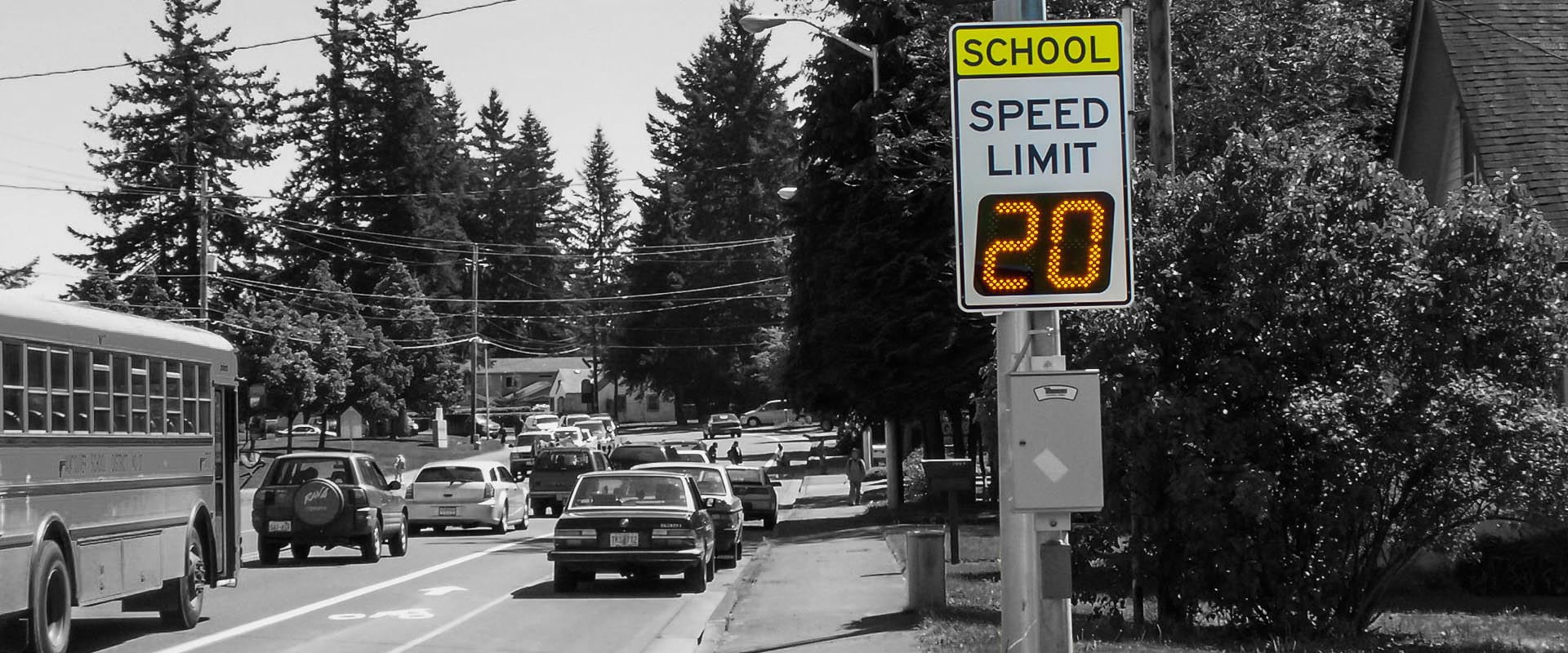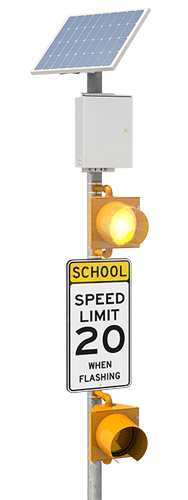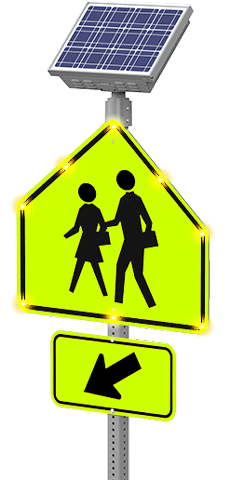Radar Speed Signs for School Zones
Capture drivers’ attention and reduce speeds by as much as 9 miles per hour.

Effective Tools for Safer Streets and Traffic Calming
Speeding drivers put others at risk, especially when pedestrians are present in school zones, on neighborhood streets, or in work zones. Well-designed radar speed displays are highly effective in getting drivers to slow down in these areas and more. Also known as driver feedback signs, these traffic calming devices detect the speed of oncoming vehicles and display the driver’s speed by flashing bright LED digits. The display is combined with a “YOUR SPEED” static sign face, making it easy for drivers to understand the intended message at a glance and react to it by slowing down. Many municipalities are finding success with speed detection signs, as they support larger traffic calming programs and walkability initiatives.
A Compliant Solution
Radar speed signs meet a variety of compliance requirements, while also aligning with safety initiatives across the US and Canada. SpeedCheck displays are a lower cost, lower maintenance alternative to sidewalks, traffic lights or speed bumps, allowing you to stretch your funds. Radar speed signs are:
- MUTCD approved
- Transport Canada approved
- Safe Routes to School aligned
- Eligible for grant funding in many cases
SpeedCheck is the most recognized radar speed sign in the industry, with thousands of installations across North America. It was the first system with an integrated LED and radar display and it remains a market leader 20+ years later. The SpeedCheck system features a unique, ultra-clear display that increases contrast and viewability while also improving driver focus. Our system is customizable, offering two-way wireless communication, a scheduling function, traffic data reporting and more.
Comprehensive school zone safety treatments
Flashing school zone beacons are the key safety tool for schools to slow down traffic. Additional products may be added that will also encourage drivers to take notice of signs and adjust their behavior.
School zones can contain:
Check your local requirements to determine compliant school zone safety options in your region.

“There is no question that radar signs enhance safety in the community. These signs are a cost-effective means of getting people to police themselves. They are relatively inexpensive considering the work they do to improve community safety.”
– Bill Dickinson, former Police Chief, Tigard, OR
Will Drivers Really Slow Down?
Whether you are installing a SpeedCheck sign on a rural highway or in a residential area, drivers will take notice. Want proof? The city of Chandler, Arizona, was faced with a growing problem with fatal collisions involving excessive speed at specific intersections—despite red-light photo enforcement. In a coordinated program, the city made key changes, including adding SpeedCheck radar feedback displays ahead of 12 problem intersections. The result was a reduction in average speed by 4 mph and 79% fewer traffic fatalities, despite far more congestion on the roadways.

Speeding was a chronic problem along a two-mile stretch of Tarpon Woods Boulevard, a collector road in Pinellas County, Florida. Citizens often complained of speeders, and studies in 2009 and 2011 showed speeds well above the posted 30 mph speed limit—an average of 38.5 mph, with 85th percentile speeds as high as 42 mph. In 2012, the Pinellas County Residential Traffic Management Program targeted this roadway for intervention, installing SpeedCheck™ radar speed displays at six locations along the route. The results were immediate—an 8 mph reduction in 85th percentile speed. The average 85th percentile speed dropped to 32 mph, with a maximum of 34.


The 5 MPH difference
By dramatically reducing the speed of the worst offenders, SpeedCheck radar speed display signs can mean the difference between life and death. Radar speed signs can slow down traffic in a school zone by as much as 9 mph, according to this study from the Texas Transportation Institute, and several studies have shown a range of around 5 to 9 mph. It may sound small, but this represents a substantial reduction in the risk of serious injury or death.
As this graphic illustrates, even if the accident is not prevented, the risk of death or serious injury is dramatically reduced with a reduction in vehicle speed
Additional Resources for Radar Speed Signs
Article
Radar Speed Signs Top Traffic Calming List They’re effective, they’re flexible, and they provide minimal disruption to traffic and neighborhoods. What’s not to love?
Case Study
Chandler, AZ Boosts Intersection Safety with Radar Speed Signs How one city coping with a population explosion greatly reduced the number of traffic fatalities at intersections.
Application Guide
Radar Speed Sign Application Guide Download this visual guide for the most common radar speed sign applications, including placement, sign legibility and MUTCD guidelines for additional features.
Video
School Zone Safety, Part 3: Radar Speed Signs Part 3 of our school zone safety video series focuses on solutions to help drivers self-correct their speed and slow down, increasing safety for all users.
Article
Radar Speed Signs Top Traffic Calming List They’re effective, they’re flexible, and they provide minimal disruption to traffic and neighborhoods. What’s not to love?
Case Study
Chandler, AZ Boosts Intersection Safety with Radar Speed Signs How one city coping with a population explosion greatly reduced the number of traffic fatalities at intersections.
Application Guide
Radar Speed Sign Application Guide Download this visual guide for the most common radar speed sign applications, including placement, sign legibility and MUTCD guidelines for additional features.
Get in touch
Have questions or need assistance? Connect with sales for product inquiries and quotes, support for technical issues, or visit the product support center for self-service resources.


